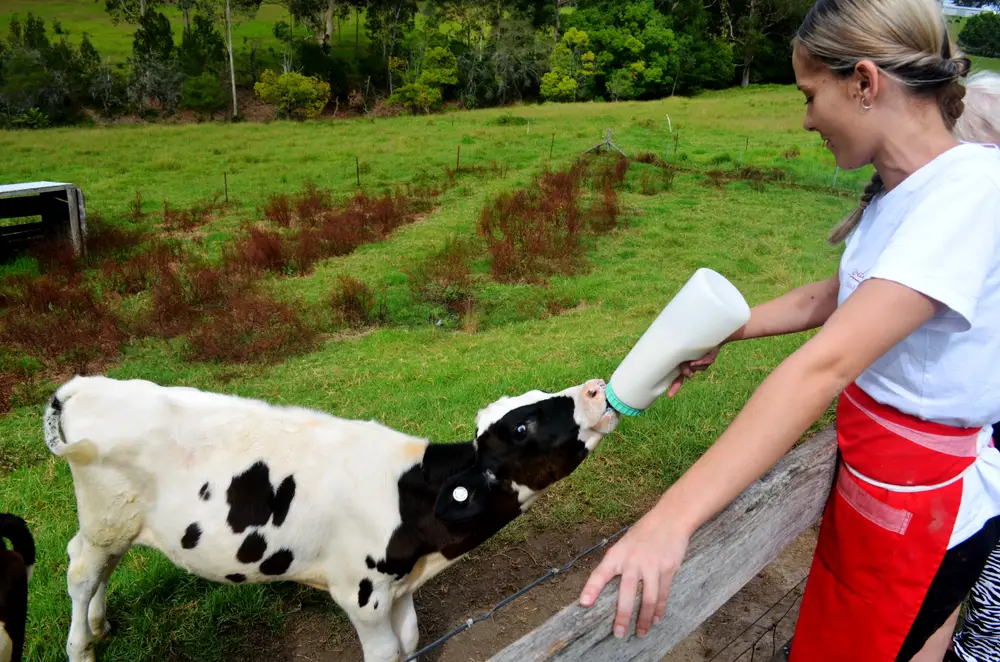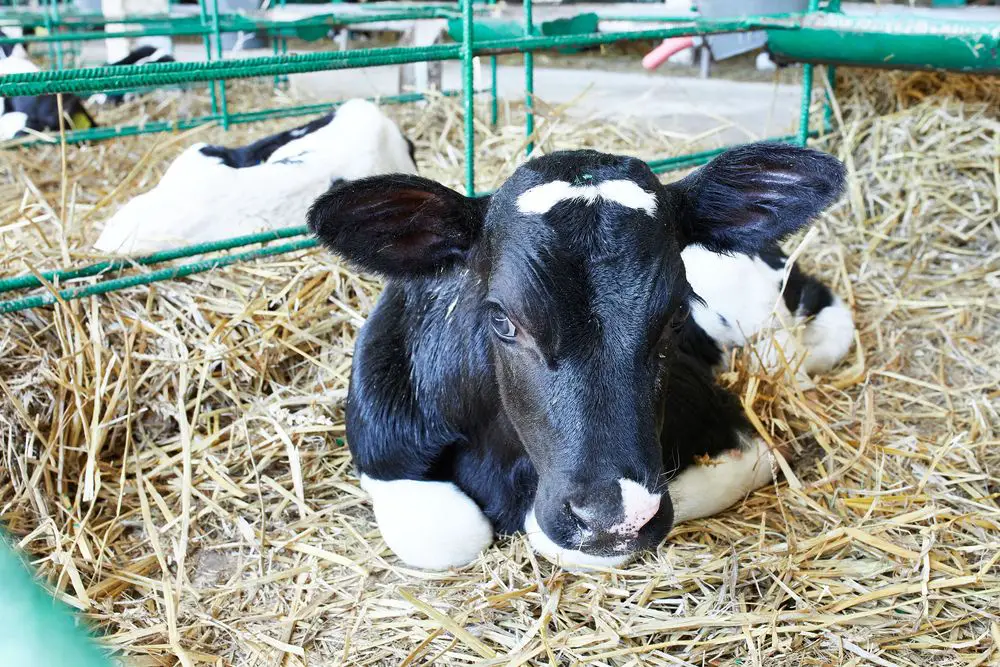Raising calves on bottled-milk is relatively easy, but requires dedication and patience. You'll need a baby cow bottle with a few different nipples, true colostrum (or alternatives), mixing buckets and a thermometer. The first time is daunting, but it becomes easier over time.
Given that a family milk cow costs $800-$3,000, you might want to start growing a herd by raising bottle calves instead to lower the start-up cost. Or you may have one or several family milk cows already and are looking to grow the herd at a lower cost.
While cutting down costs isn’t the only reason you’ll have a bottle-fed calf, it’s still a great way to increase your herd. Bottle-feeding a calf is easy, but it can be tricky when doing it for the first time.
Here’s what you need to know to get started on the right foot in raising a bottle calf.
Table of Contents
What Defines A Bottle Calf?
Different situations may seal the fate of a newborn calf to grow up feeding by the bottle, including:
- The calf’s mother died, leaving it as an orphan calf.
- The mother rejected the newborn calf (a heifer calving for the first time may not be too comfortable with a baby cow head-butting her because she hasn’t developed good mothering instincts yet).
- The calf was rejected by its assigned nursing cow or substitute mother (think of your lactating dairy cow refusing the newborn calf because it’s not hers).
- The calf was born in a setup where it can’t be raised, such as in a slaughterhouse, a dairy farm that doesn’t rear male calves, or a beef farm that won’t raise a beef cow (female).
- The calf got separated from the mother early on.
- You bought the calf from a sale barn or cattle auction (avoid buying a calf here before trying other alternatives as it’s hard to tell what ailments the calf may have).
- You adopted the calf from a friend.
- You opted for a bottle calf because you don’t have enough money to buy a full-grown cow.
How Long Does Feeding A Calf Off The Bottle Take?
Each feeding session takes between 10 and 15 minutes, depending on how much feed you are giving, the age of the calf, its health or fitness, and its experience with bottle feeding. Expect to do this 2 to 3 times per day.

What You’ll Need To Bottle-feed Your Calf
Bottle-feeding calves simply requires a few items and does become easier through patience and experience. Here’s what you’ll need:
- True colostrum (obtained in the first milking after calving down). Colostrum obtained from subsequent milkings in the first 3-4 days is also okay.
- Commercial colostrum replacement if true colostrum is not available
- Whole milk, safe waste milk, or reconstituted milk replacer
- Calf starter feed, high-quality hay, grass pasture, and grain
- Shelter: Bottle-fed calves generally have weaker immunities and require extra care in clean, warm, and cozy shelters. If you raise several bottle calves, house them individually so they don’t suck one another.
- Baby cow bottles and nipples: Standard calf bottles carry two liters of milk. You can test a few nipples to see the size and flow your calf will like the most.
- Mixing whisk or mixer: Reconstituting the milk replacer involves mixing it with warm water to a smooth consistency.
- Thermometer: This comes in handy for measuring the temperature of the water before mixing it with the replacer to avoid denaturing the proteins and fats, and to avoid burning the hungry calf.
- Milking buckets or containers with spouts and calibrations. Spouts make pouring milk into the bottle less messy, while calibrations ensure you don’t underfeed or overfeed the calf.
- Electrolyte solution. This comes in handy for curing dehydration if the calf suffers from scours.
Milk-Based Feeds For Bottle Calves
Let’s take a deeper look at different milk-based feeds for bottle calves.
Colostrum
For a wholesome diet, young calves should be fed true colostrum within 24 hours, but preferably within the first hour after birth when their bodies can best absorb antibodies present in that first calf milk.
You can store the remaining colostrum to ferment for later feeding instead of throwing it away. Properly fermented colostrum can stay for up to 30 days when stored away from direct sunlight.
The calf can start feeding on fermented colostrum from 4 days of age, but you should dilute it with warm water by mixing 2 parts of the colostrum with 1 part of warm water.
Where fresh or fermented colostrum is not available, you can purchase commercial colostrum instead.
Whole Milk
Alternatively, you can use whole milk from another cow, provided she is healthy.
Waste Milk
Waste milk is also a good option, such as mastitic milk, but the cow shouldn’t be on antibiotics or have advanced mastitis. The calf must also be kept alive (not slaughtered for meat) for another 8-12 weeks after feeding on waste milk from a treated cow.
Milk Replacers
Milk replacer powder also forms a good part of the calf’s diet in the first 3 weeks of age and should be mixed with warm water before being fed to the calf.
When you reconstitute the powder or fermented colostrum with warm water, the key is to allow it to cool down to the calf’s body temperature before feeding it.
You can continue feeding the baby cow the milk replacer beyond 3 weeks to up to 8-10 weeks before weaning it, depending on the calf’s progress. Some calves may go up to 12 weeks on bottle milk.
The milker replacer should contain whey products and at least 18-22% crude fat, less than 0.5% crude fiber, and 10-22% crude fat. You can buy milk replacers or commercial colostrum from a reliable brand such as Manna Pro.
The right amount of colostrum or milk replacer to feed the calf is about 10% of the calf’s body weight, though the needs of each calf may vary, with some requiring more or less.
You’ll want to feed your calf less during hot seasons, while the cold season calls for more feed to provide extra warmth.
Bottle feeding should happen 2-3 times a day for strong and large calves consuming a bottle of milk at each feeding. Smaller and sickly calves must be fed smaller amounts of milk several times daily.
The amount of feed may also differ from breed to breed. For example, Holstein cattle are heavy feeders, and their calves require more feed than other breeds like Jersey.
Other Feeds To Offer Baby Cows Alongside Milk
Besides the milk-based products, you can provide other feeds such as calf starter from 4 days old, calf pellets, small amounts of pasture, good quality hay, and calf grower (feed the calf on grower from about four months of age).

The hay and pasture offered besides milk-based feeds ensure the rumen develops in good time, both in size and the useful bacteria required for a healthy digestive system.
Electrolytes come in handy if the calf suffers from scours because of overfeeding or an infection. Calf scours refers to calf diarrhea and may cause dehydration, drops in body temperature, lethargy, and even death.
To reverse calf scours, work closely with a vet to identify the cause and design a preventative and recovery program. However, you can give your calf electrolytes early on, preferably an isotonic one.
Weaning the calf off the bottle should be done gradually to avoid causing your baby cow unnecessary stress. The best weaning time is at 8 weeks old, but some calves can have it as early as 4 weeks old. Some will require 10 or 12 weeks.
When baby calves are comfortably feeding on 1.5-2 pounds of calf starter daily for three consecutive days, you can start reducing the amount of calf milk over 3-7 days before stopping completely.
Fresh, clean water must be made available for the calf on a free-choice basis from 4 days old.
General Tips When Feeding Baby Calves Off A Bottle
- Every new calf will treat the nipple as the cow’s teat and the whole bottle as the udder. It’s not unusual to see the calf head-butting the bottle like it would the udder of its mother.
- To prevent injury from head-butting, the bottle holder should always be alert and stand separated from the calf by a fence with space where the bottle goes through.
- A bottle-fed calf grows relatively slowly in the first 6-8 months but soon catches up with other calves.
- To ensure you offer the best calf care in feeding, always strike a balance with the meals to avoid overfeeding that causes scours or underfeeding that robs the calf of vital nutrients and slows growth.
- Stick to a routine when feeding milk and other supplements.
- Ensure you withdraw the bottle immediately after the milk is depleted so that the baby cow doesn’t suck air.
